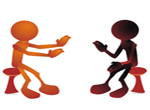 by Regina Kim
by Regina Kim
Generally speaking, there are two types of people in this world – competitors and cooperators.
Not surprisingly, when a cooperator interacts with another cooperator in conflict, he cooperates with the other to reach an outcome that is beneficial to both of them. And when a competitor interacts with another competitor, she competes against the other to reach an outcome that is most beneficial to her.
But what happens when a cooperator meets a competitor? There’s bad news and good news.
Researchers have observed the behaviors of competitor – cooperator interactions during the Prisoner’s Dilemma game[i] and they found: 1) the cooperator usually matches the behaviors of the competitor, 2) this makes the competitor perceive the cooperator as competitive, and then 3) the conflict escalates. This is the bad news.
But after cooperators interact with competitors, they readily return to cooperative behaviors if the partner becomes similarly inclined. In this sense, cooperators are more sensitive to the goals and tactics of the others and match their behaviors accordingly. On the other hand, competitors often fail to see that their competitiveness causes the cooperators to engage in competitive behaviors. Without this awareness, they misjudge the cooperators as competitors and believe that others are uniformly competitive.
This may explain why we tend to stereotype certain industries, such as law firms and business consulting firms, as highly competitive. The nature of these industries may attract people with more competitive personalities, but even the more cooperative ones will start to behave competitively in these environments. As a result, these industries evolve toward having most, if not all competitive individuals.
So, if you are the type of person who thinks everyone around you is competitive, it just might be that some of the competitive interactions you have with others are the result of your own doing. Competitors reap what they sow.
Kelley, H.H. & Stahelski, A. J. (1970). Social Interaction basis of cooperators’ and competitors’ beliefs about others. Journal of Personality and Social Psychology, 16, 66-91.